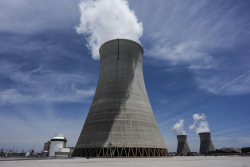
astronomer: A scientist who works in the field of research that deals with celestial objects, space and the physical universe.
black hole: A region of space having a gravitational field so intense that no matter or radiation (including light) can escape.
cloud: A plume of molecules or particles, such as water droplets, that move under the action of an outside force, such as wind, radiation or water currents. (in atmospheric science) A mass of airborne water droplets and ice crystals that travel as a plume, usually high in Earth’s atmosphere. Its movement is driven by winds.
core: Something — usually round-shaped — in the center of an object.
element: A building block of some larger structure. (in chemistry) Each of more than one hundred substances for which the smallest unit of each is a single atom. Examples include hydrogen, oxygen, carbon, lithium and uranium.
fuel: Any material that will release energy during a controlled chemical or nuclear reaction. Fossil fuels (coal, natural gas and petroleum) are a common type that liberate their energy through chemical reactions that take place when heated (usually to the point of burning).
gravity: The force that attracts anything with mass, or bulk, toward any other thing with mass. The more mass that something has, the greater its gravity.
mass: A number that shows how much an object resists speeding up and slowing down — basically a measure of how much matter that object is made from.
nebula: A cloud of space gas and dust existing between major adult stars. Telescopes can detect these clouds by the light they emit or reflect. Some nebulas also appear to serve as the nurseries in which stars are born.
neutron star: The very dense corpse of what had once been a massive star. As the star died in a supernova explosion, its outer layers shot out into space. Its core then collapsed under its intense gravity, causing protons and electrons in its atoms to fuse into neutrons (hence the star’s name). A single teaspoonful of a neutron star, on Earth, would weigh more than a billion tons.
planet: A large celestial object that orbits a star but unlike a star does not generate any visible light.
pulsar: The name for a spinning, ultra-dense neutron star. A single teaspoonful, on Earth, would weigh a billion tons. It represents the end of life for stars that had started out having four to eight times the mass of our sun. As the star died in a supernova explosion, its outer layers shot out into space. Its core then collapsed under its intense gravity, causing protons and electrons in the atoms that had made it up to fuse into neutrons (hence the star’s name). When these stars rotate, they emit short, regular pulses of radio waves or X-rays (and occasionally both at alternate intervals).
star: The basic building block from which galaxies are made. Stars develop when gravity compacts clouds of gas. When they become hot enough, stars will emit light and sometimes other forms of electromagnetic radiation. The sun is our closest star.
sun: The star at the center of Earth’s solar system. It is about 27,000 light-years from the center of the Milky Way galaxy. Also a term for any sunlike star.
supernova: (plural: supernovae or supernovas) A star that suddenly increases greatly in brightness because of a catastrophic explosion that ejects most (or sometimes all) of its mass.
universe: The entire cosmos: All things that exist throughout space and time. It has been expanding since its formation during an event known as the Big Bang, some 13.8 billion years ago (give or take a few hundred million years).
white dwarf: A small, very dense remains of a star that is now the size of a planet. It is what is left when a star with a mass about the same as our sun has exhausted its nuclear fuel of hydrogen and cast off its outer layers.








Leave a Comment